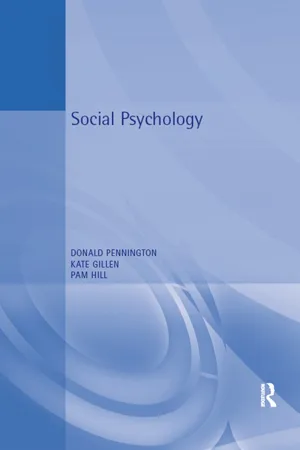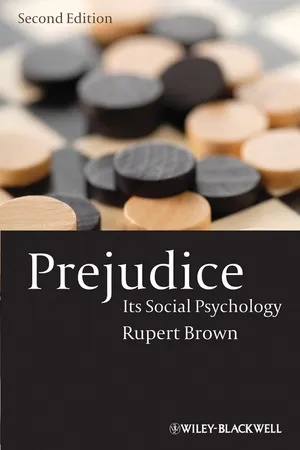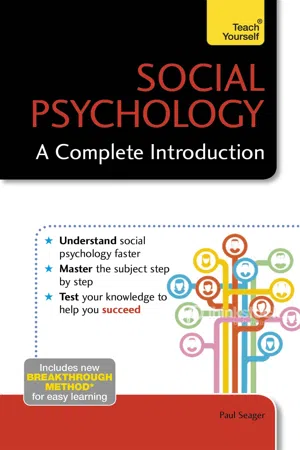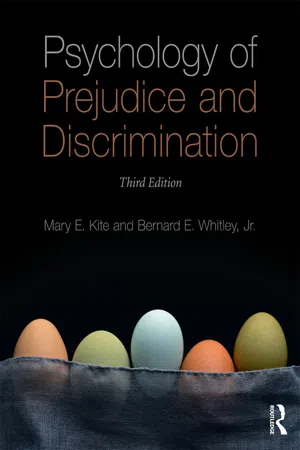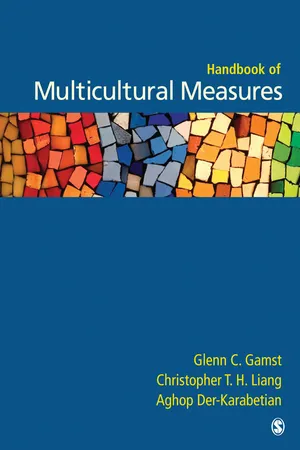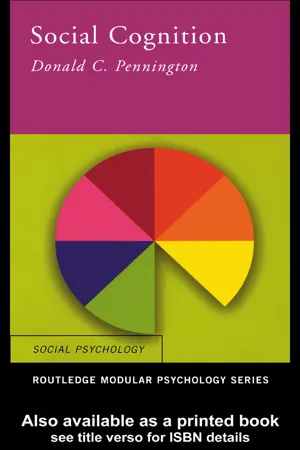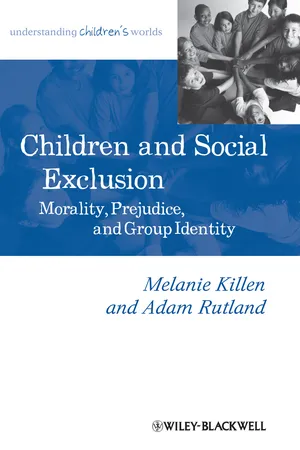Explanations for Prejudice
Explanations for prejudice in psychology include social identity theory, which suggests that people favor their in-group over out-groups to enhance their self-esteem, and realistic conflict theory, which posits that prejudice arises from competition for limited resources. Additionally, the social cognitive perspective emphasizes the role of cognitive processes, such as categorization and stereotyping, in shaping prejudiced attitudes and behaviors.
8 Key excerpts on "Explanations for Prejudice"
- eBook - ePub
Understanding Vulnerability
A Nursing and Healthcare Approach
- Vanessa Heaslip, Julie Ryden, Vanessa Heaslip, Julie Ryden(Authors)
- 2013(Publication Date)
- Wiley-Blackwell(Publisher)
...While these and other possible reasons may appear very distinct, many of these explanations can relate to the concept of control. So far in this chapter, we have explored how cognitive and social psychology offer us many explanations of how and why we discriminate against each other. A set of theories and research which have contributed enormously to our understanding of the human propensity to treat each other badly is the psychology of prejudice. Box 7.9 Activity Consider the following questions and answer them based on your current knowledge, experience, and beliefs. Are we bound to be prejudiced in some way, whatever we do? Can prejudice be a good thing? Are some individuals more likely to be prejudiced than others? Can we become more or less prejudiced depending on the situation we find ourselves in? Can we ‘catch’ prejudice, become ‘infected’ with it? We will come back to them after you have considered the psychological evidence. Prejudice: Psychological perspectives Understanding how prejudice comes about is extremely helpful in explaining why people are discriminated against and oppressed but also offers an evidence base of how to combat prejudice and thus reduce vulnerability. Before we continue to consider the evidence base, we shall start by exploring your perspectives in the activity in Box 7.9. How has prejudice been defined and explained by psychology? Attribution theory is a well-established explanation of how we steer ourselves through complex social interactions generally, and false attributions in everyday life are often fleeting and have little impact on people’s lives. However, we have seen the harm that can be done when our attributions are wrong, and negative, in the more intense world of health and social care, as they can lead to prejudice. Psychologists have also studied prejudice as a separate entity...
- eBook - ePub
- Richard Gross, Rob McIlveen(Authors)
- 2016(Publication Date)
- Routledge(Publisher)
...Adapted from Rokeach (1968, pp. 69–71) In summary, individual levels of explanation put forward by social psychologists to explain prejudice and discrimination all suffer quite severe shortcomings, as we have seen. Nevertheless, explanations that focus on the individual remain of interest in research terms and are intuitively appealing to people. Why is this? It may be that this can be explained in part by reference to the attribution approach in Chapter 5, for example, the correspondence bias (Section 5.4.1) is where people have a strong tendency to attribute behaviour to dispositions. This bias results in a focus on individual aspects such as personality, beliefs, frustration–aggressive behaviour, which are precisely the types of explanation we have been considering. 10.4 Realistic group conflict Group membership itself may be an important explanation for prejudice and discrimination. So far we have largely ignored the effects and consequences of belong to a group and how people treat members of their own group compared with members of other groups to which they do not belong or identify with. Social psychologists have looked at this from two perspectives; first, where two or more groups are in competition for resources, and, second, how group membership per se affects a person’s attitudes and behaviour. In this section we consider the former perspective and in Section 10.5 the effects of social categorisation in the absence of competition for resources. In a series of highly influential and pioneering experiments Sherif (1966) investigated intergroup conflict and co-operation in groups of 11–12 year old boys attending summer school camp in America. The field experiments lasted three weeks and were characterised by three stages each lasting a week: Stage 1: The boys were put in one of two conditions for the first week. In condition (a) the boys spent a week together where they were involved in various informal activities...
- eBook - ePub
Prejudice
Its Social Psychology
- Rupert Brown(Author)
- 2011(Publication Date)
- Wiley-Blackwell(Publisher)
...This cognitive analysis is undoubtedly important; indeed I shall be devoting two whole chapters to it (Chapters 3 and 4). However, to ignore the emotionally laden – one might even say saturated – nature of prejudice as it is actually perpetrated and experienced in everyday life is, it seems to me, to overlook something rather fundamental about it. Thus a recurring theme in the pages that follow will be the interplay between the cognitive, the affective and the behavioural processes implicated in prejudice. A Social Psychological Approach Having defined what I mean by prejudice, I should say a few words about the general approach I shall be adopting throughout the book. At this stage, I shall outline the perspective only in rather broad terms, without very much supportive evidence and argumentation. Its more detailed documentation will be left to subsequent chapters. The first point to make is that I see prejudice as primarily a phenomenon originating in group processes. There are three closely related reasons why this is so. First, it is, as I have chosen to define it, an orientation towards whole categories of people rather than towards isolated individuals. Even if its target in any concrete instance is only a single individual (as in the example with which I began the previous section), nevertheless that person’s individual characteristics matter much less than the markers that allocate him or her to one group rather than another – by name, by accent, by skin colour, and so on. The second reason why prejudice should be regarded as a group process is that it is most frequently a socially shared orientation. That is to say, large numbers of people in a segment of society will broadly agree in their negative stereotypes about any given outgroup and will behave in a similar way towards its members...
- Paul Seager(Author)
- 2014(Publication Date)
- Teach Yourself(Publisher)
...This suggests that prejudice was much more likely due to the prevailing societal norms than it was to individual differences. • It is difficult to explain how prejudice found in an entire population or society can actually be down to individual differences. In effect, it would be saying that thousands, and possibly tens of thousands, of people are different on so many other personality traits, such as introversion-extraversion, agreeableness, and the like, but they all happen to be the exactly the same on personality traits linked to prejudice. • From a historical perspective, it has been found that prejudice in individual societies can emerge in a very short space of time, such as anti-Japanese sentiment in the USA following the bombing of Pearl Harbor, or Islamophobia following 9/11; as such, it is unlikely that individual personality traits can really account for such situations. More typically, prejudice tends to be seen as an intergroup process (see also Chapter 14), and there are a number of theories that attempt to explain prejudice from this perspective. Intergroup explanations of prejudice There are a number of different theories that can account for intergroup explanations of prejudice, and these have been covered in other chapters looking at aggression and intergroup conflict. However, it is worth briefly reprising some of them here as a reminder. The ‘ frustration-aggression hypothesis’ (see Chapter 9) puts forward the idea that a frustrating situation, such as a poor economic climate, can lead to aggression; importantly, the aggression tends not to be targeted towards the cause of the frustration, which is usually a more powerful target, but instead is likely to be displaced towards an easier and weaker target, such as an ethnic minority...
- eBook - ePub
Psychology of Prejudice and Discrimination
3rd Edition
- Mary E. Kite, Bernard E. Whitley, Jr.(Authors)
- 2016(Publication Date)
- Routledge(Publisher)
...In general, although heterosexual women and men tend to maintain the belief that homosexuality is wrong from early adolescence through young adulthood, other beliefs change as they get older. However, these attitudes can be very context-dependent. For example, Horn (2010) notes that reported discomfort with interacting with gay and lesbian peers increases as the intimacy of the situation increases. Thus, heterosexual adolescents report little discomfort with working with gay or lesbian peers on school committees, but much more discomfort with the possibility of having to share a room with a gay or lesbian peer on a school trip. Also, acceptance of anti-gay behavior declines as its severity increases; for example, exclusion is seen as more acceptable than harassment or assault. Four types of theories have been used to explain the development of prejudice in children. Genetic theories hold that attitudinal precursors to prejudice are passed from generation to generation through biological inheritance. Cognitive developmental theories focus on how children’s views of people change as their cognitive abilities improve with age. Social learning theories explain prejudice in terms of direct reinforcement, modeling and imitation, and vicarious learning. Direct teaching of prejudice is not very common; indirect teaching of prejudice from live models (for example, family members, peers, and teachers) and symbolic models in the media are primarily responsible for the learning of prejudiced attitudes. Developmental intergroup theory posits that prejudice arises as a byproduct of normal cognitive developmental processes. Children are motivated to understand how the world works. Sorting elements of their environments into categories is a basic mechanism that helps in understanding the world. Children initially derive categories based on the physical characteristics of people, such as skin color...
- eBook - ePub
- Glenn C. Gamst, Christopher T. H. Liang, Aghop Der-Karabetian(Authors)
- 2010(Publication Date)
- SAGE Publications, Inc(Publisher)
...For instance, there has been an incredible growth in the body of literature addressing the psychological sequelae of racism on Asian Americans (e.g., Alvarez, Juang, & Liang, 2006; Gee, Delva, & Takeuchi, 2006; Lee, 2003, 2005; Liang, Alvarez, Juang, & Liang, 2007; Liang & Fassinger, 2008; Noh & Kaspar, 2004; Yoo, Burrola, & Steger, 2010; Yoo & Lee, 2005). Researchers also have studied the racial experiences of Latino/a Americans (e.g., Alderete, Vega, Kolody, & Aguilar-Gaxiola, 1999; Cassidy, O’Conner, Howe, & Warden, 2004; Finch, Kolody, & Vega, 2000; Moradi & Risco, 2006) and have begun to explore discrimination encountered by Arab Americans (e.g., Moradi & Hasan, 2004). Shifting their attention from the formation of prejudicial attitudes among White Americans, researchers also have begun to understand the costs of racism to Whites (e.g., Spanierman & Heppner, 2004). Aiding the proliferation of these studies has been the increased attention to the development of race-related measures (see Bastos, Celeste, Faerstein, & Barros, 2010; Kressin, Raymond, & Manze, 2008). 7.3 THEORETICAL FOUNDATIONS Racism and prejudice research has been guided by theory. Studies with a focus on prejudice initially relied on psychodynamic perspectives (e.g., Adorno et al., 1950), but these studies with their focus on individual-level differences were acontextual and could not address institutional racism (Duckitt, 1992). Gordon Allport’s seminal book, The Nature of Prejudice (Allport, 1954), also was highly influential in the study of prejudice as it served as the foundation for subsequent conceptualizations (i.e., social-cognitive and social identity; Dovidio, 2001). The social-cognitive perspective (Hamilton, 1981) has led to studies of people’s cognitions as they relate to people, groups, or social situations...
- eBook - ePub
- Donald C. Pennington(Author)
- 2012(Publication Date)
- Routledge(Publisher)
...We will also consider the relative deprivation theory account of prejudice. Two other approaches, based on individual psychology, will also be considered —the authoritarian personality, and frustration aggression. The chapter concludes by looking at a number of strategies which may reduce prejudice, discrimination and intergroup conflict. First, we will define terms and consider some examples of prejudice and discrimination. Prejudice may be defined as: an unjustified negative (or positive) attitude toward an individual based solely on that individual’s membership in a group (Worchel et al., 1988) This definition is helpful since it characterises prejudice as unjustified and highlights the fact that an individual is only the target of prejudiced attitudes because he or she is perceived to be a member of a group. It is the group as a whole that the prejudicial attitudes are focused on. Note also that whilst most prejudice is concerned with negative attitudes one can be prejudiced in a positive way—for example, unjustifiably favouring an individual just because he or she is perceived to belong to a group we hold in high regard. Discrimination refers to the actual behaviours, rather than attitudes, and may be defined as: Negative (or sometimes positive) actions taken towards members of a particular group because of their membership in the group. (Feldman, 1998) Discrimination then, is the actual behaviour an individual or group of people engage in as a result of holding stereotypical and prejudiced attitudes. Whilst we normally expect discrimination to reflect and follow on from attitudes a person holds, it may often be the case that a person is prejudiced but makes no overt display of this through what they do or say. In both the examples given at the start of this chapter, extreme forms of discrimination have occurred. However, soldiers in the Serbian army may not as individuals hold prejudiced attitudes, but simply be obeying orders...
- eBook - ePub
Children and Social Exclusion
Morality, Prejudice, and Group Identity
- Melanie Killen, Adam Rutland(Authors)
- 2011(Publication Date)
- Wiley-Blackwell(Publisher)
...Studies have failed to find significant correlations between parental levels of prejudice and child manifestations of prejudice (e.g., Aboud & Doyle, 1996). It appears that while young children may incorporate negative words into their descriptions of minority groups (see Nesdale, 2001b) these attributions do not reflect stable or internalized attitudes amongst children. The conclusion one is forced to face when considering this evidence is that the effects of simple socialization on children's prejudice are seldom constant; the unidirectional characterization of socialization has not been supported in many areas of child development, and not in the area of prejudice acquisition. Psychologists moved away from simple socialization models of prejudice development to a focus on the social-cognitive basis of childhood prejudice. This reflected a challenge to behaviorist accounts generally within psychology and a realization that children actively construct their understanding of the social world in everyday interaction utilizing their emerging cognitive and social-cognitive abilities. Cognitive Developmental Approach to Prejudice Development The cognitive developmental approach to prejudice development contends that a young child's cognitive limitations lead them to show biases. These biases become less likely as children develop the ability to think flexibly, though, and to use multiple social categories (i.e., a boy can see another child as both a girl and a brave child). Cognitive developmental stage theories propose that a child's ability to solve problems could be characterized by broad structural changes in thinking, from one-way functions in early childhood to the concrete operations of reversibility in middle childhood to abstract hypothetical principles in adolescence...

